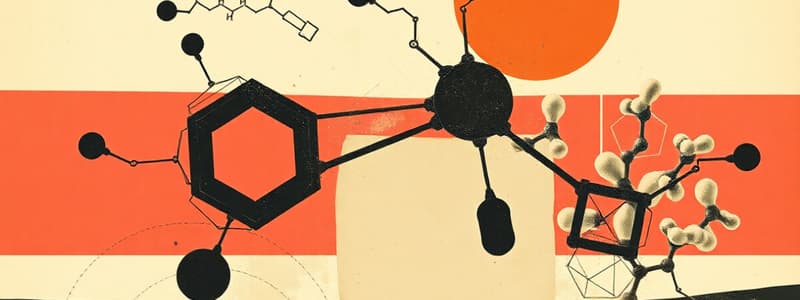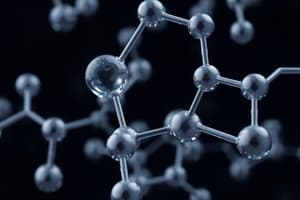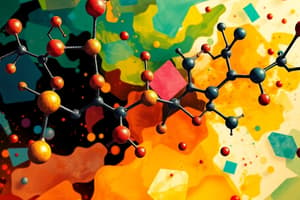Podcast
Questions and Answers
Which functional group is most likely to participate in a reaction with another molecule?
Which functional group is most likely to participate in a reaction with another molecule?
- Methyl group
- Hydroxyl group (correct)
- Carbon-carbon single bond
- Non-polar hydrocarbon chain
A carboxyl group can behave as an acid because it can:
A carboxyl group can behave as an acid because it can:
- Accept a hydrogen ion ($H^+$)
- Share electrons
- Release a hydrogen ion ($H^+$) (correct)
- Donate electrons
Which of the following is NOT a characteristic of a functional group?
Which of the following is NOT a characteristic of a functional group?
- Participates in chemical reactions
- Affects how a molecule reacts
- Forms covalent bonds with other nonpolar portions of a biological molecule (correct)
- Typically ionic or strongly polar
What type of molecules are composed of building blocks containing amino and carboxyl groups?
What type of molecules are composed of building blocks containing amino and carboxyl groups?
Which of the following molecules are most accurately described as very polar?
Which of the following molecules are most accurately described as very polar?
Which of the following would be directly involved in dehydration synthesis?
Which of the following would be directly involved in dehydration synthesis?
Which of the following is NOT true about the non-polar hydrocarbon portions of biological molecules?
Which of the following is NOT true about the non-polar hydrocarbon portions of biological molecules?
What is considered the building block of nucleic acids?
What is considered the building block of nucleic acids?
What is a primary structural characteristic of polysaccharides?
What is a primary structural characteristic of polysaccharides?
What is the main function of polysaccharides in living organisms?
What is the main function of polysaccharides in living organisms?
Which of the following is NOT an example of a polysaccharide?
Which of the following is NOT an example of a polysaccharide?
What key process occurs during dehydration synthesis?
What key process occurs during dehydration synthesis?
Which process involves the use of water to split large molecules into smaller subunits?
Which process involves the use of water to split large molecules into smaller subunits?
What is the role of salivary amylase in carbohydrate digestion?
What is the role of salivary amylase in carbohydrate digestion?
Why do lipids not dissolve in water?
Why do lipids not dissolve in water?
What is the main function of triglycerides?
What is the main function of triglycerides?
What is the primary role of carbon in biological macromolecules?
What is the primary role of carbon in biological macromolecules?
Which characteristic of carbon atoms allows for the vast diversity of organic molecules?
Which characteristic of carbon atoms allows for the vast diversity of organic molecules?
What type of chemical reaction involves the removal of water to join monomers into polymers?
What type of chemical reaction involves the removal of water to join monomers into polymers?
What is the main process by which polymers are broken down into monomers?
What is the main process by which polymers are broken down into monomers?
Which of the following is NOT considered a major type of biological macromolecule?
Which of the following is NOT considered a major type of biological macromolecule?
If a molecule has polar or ionic qualities how will it interact with other molecules?
If a molecule has polar or ionic qualities how will it interact with other molecules?
Which statement best defines the role of a functional group in a biological molecule?
Which statement best defines the role of a functional group in a biological molecule?
Which of the following best represents the dry weight composition of a cell?
Which of the following best represents the dry weight composition of a cell?
Flashcards
Polysaccharide structure
Polysaccharide structure
Very long, straight or branched chains of simple sugar monomers linked by glycosidic bonds.
Polysaccharide function
Polysaccharide function
Polysaccharides serve as energy stores, structural components, and even participate in cell communication.
Polysaccharide examples?
Polysaccharide examples?
Examples of polysaccharides include starch, glycogen, cellulose, and chitin.
Dehydration Synthesis
Dehydration Synthesis
Signup and view all the flashcards
Hydrolysis
Hydrolysis
Signup and view all the flashcards
What are lipids?
What are lipids?
Signup and view all the flashcards
Lipids - function?
Lipids - function?
Signup and view all the flashcards
What is a triglyceride?
What is a triglyceride?
Signup and view all the flashcards
What are monosaccharides?
What are monosaccharides?
Signup and view all the flashcards
What is a functional group?
What is a functional group?
Signup and view all the flashcards
What's the difference between a hydrocarbon chain and a functional group?
What's the difference between a hydrocarbon chain and a functional group?
Signup and view all the flashcards
How does dehydration synthesis work?
How does dehydration synthesis work?
Signup and view all the flashcards
What is hydrolysis?
What is hydrolysis?
Signup and view all the flashcards
Why is hydrolysis important for digestion?
Why is hydrolysis important for digestion?
Signup and view all the flashcards
Why is dehydration synthesis important for the body?
Why is dehydration synthesis important for the body?
Signup and view all the flashcards
How do functional groups contribute to interactions with other molecules?
How do functional groups contribute to interactions with other molecules?
Signup and view all the flashcards
Carbon's role in biological molecules
Carbon's role in biological molecules
Signup and view all the flashcards
Carbon's ability to form various structures
Carbon's ability to form various structures
Signup and view all the flashcards
Carbon's valence electrons
Carbon's valence electrons
Signup and view all the flashcards
Functional groups in organic molecules
Functional groups in organic molecules
Signup and view all the flashcards
Dehydration reaction
Dehydration reaction
Signup and view all the flashcards
Hydrolysis reaction
Hydrolysis reaction
Signup and view all the flashcards
Macromolecules: The building blocks of life
Macromolecules: The building blocks of life
Signup and view all the flashcards
Four main types of macromolecules
Four main types of macromolecules
Signup and view all the flashcards
Study Notes
Carbon Chemistry of Life
- Carbon atoms form the backbone of biological molecules
- Carbon can form single, double, and triple covalent bonds.
- Functional groups affect how molecules interact
- Dehydration synthesis removes water to combine subunits
- Hydrolysis uses water to break down larger molecules
Biological Macromolecules
- Carbohydrates, lipids, proteins, and nucleic acids are major types of biological molecules.
- Carbohydrates are the principle energy source. Monosaccharides are the fundamental elements which bond together to construct larger carbohydrates
- Lipids store energy and form cell membranes
- Proteins are involved in diverse processes, including catalyzing reactions
- Nucleic acids store genetic information
Carbohydrates
- Monosaccharides are the simplest carbohydrates (e.g., glucose, fructose, galactose).
- Disaccharides are formed by combining two monosaccharides through dehydration reactions. (e.g. maltose, sucrose, lactose.)
- Polysaccharides are complex carbohydrates formed by many monosaccharides bonded together. (e.g., glycogen, starch, cellulose).
- Hydroxyl functional groups make sugars soluble in water
Lipids
- Lipids are a diverse group that do not dissolve in water
- Triglycerides, a type of lipid, comprise three fatty acids attached to glycerol
- Fatty acids can be saturated or unsaturated, impacting their physical properties
- Phospholipids build cell membranes because they are the fundamental structural component. Phospholipids in a bilayer organize themselves creating a membrane with polar hydrophilic heads that are soluble in water, and a non-polar hydrophobic tails that are insoluble in water.
Proteins
- Amino acids are the building blocks of proteins
- Proteins have diverse functions due to their different sequences and shapes
- Proteins are composed of chains of amino acids linked by peptide bonds
- Proteins assume 4 different levels of structure (primary, secondary, tertiary, and quaternary)
Nucleic Acids
- Nucleic acids store genetic information and function in gene expression
- DNA and RNA are composed of nucleotides, each containing a pentose sugar, a nitrogenous base and one to three phosphate groups
- DNA (deoxyribonucleic acid) is a double helix.
- RNA (ribonucleic acid) is single-stranded.
- The specific sequence of nucleotides in nucleic acids directs protein synthesis.
Enzymes
- Enzymes are biological catalysts that speed up chemical reactions
- Enzymes are proteins with an active site that fits a specific substrate
- Enzyme function is highly sensitive to environmental conditions like temperature.
Studying That Suits You
Use AI to generate personalized quizzes and flashcards to suit your learning preferences.
Related Documents
Description
Test your knowledge on the carbon chemistry of life and the major biological macromolecules. Explore the roles of carbohydrates, lipids, proteins, and nucleic acids, as well as the processes of dehydration synthesis and hydrolysis. This quiz covers essential concepts for understanding the molecular basis of life.




